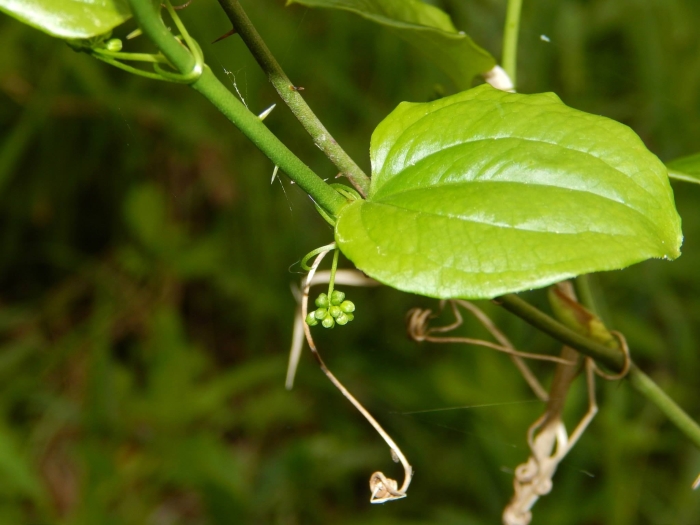Bristly Greenbrier
(Smilax hispida)
Bristly Greenbrier (Smilax hispida)
/
/

Tim Hammer
CC BY 4.0
Image By:
Tim Hammer
Recorded By:
Copyright:
CC BY 4.0
Copyright Notice:
Photo by: Tim Hammer | License Type: CC BY 4.0 | License URL: http://creativecommons.org/licenses/by/4.0/ | Rights Holder: Tim Hammer | Publisher: iNaturalist | Date Created: 42133 |























Estimated Native Range
Summary
Smilax tamnoides, commonly known as bristly greenbrier, is a climbing, prickly vine native to a variety of habitats including moist woodlands, thickets, and along stream banks in the Southeastern, Central and Northeastern United States. This perennial plant can grow to lengths of 10-15 feet (3-4.5 meters) and uses tendrils to support itself on other vegetation. It produces small, green to brown flowers in umbels during the spring, which are not particularly showy but are followed by clusters of blue to black berries that are attractive to wildlife. The leaves are glossy green and can provide dense coverage, making it useful for naturalistic plantings.
Bristly greenbrier is valued for its ability to form thick, impenetrable thickets, providing excellent cover and nesting sites for birds and small mammals. It is often used for wildlife habitat restoration and erosion control due to its vigorous growth habit. In cultivation, it prefers partial to full shade, moist but well-drained soils, and is tolerant of a range of soil types, including sandy and clay soils. While it is relatively low-maintenance, it can become aggressive in favorable conditions. Gardeners should be aware that the thorns can make handling difficult, and it may require management to keep it in check. Smilax hispida is potentially invasive in some parts of the world, and caution should be exercised before planting it outside its native range.CC BY-SA 4.0
Bristly greenbrier is valued for its ability to form thick, impenetrable thickets, providing excellent cover and nesting sites for birds and small mammals. It is often used for wildlife habitat restoration and erosion control due to its vigorous growth habit. In cultivation, it prefers partial to full shade, moist but well-drained soils, and is tolerant of a range of soil types, including sandy and clay soils. While it is relatively low-maintenance, it can become aggressive in favorable conditions. Gardeners should be aware that the thorns can make handling difficult, and it may require management to keep it in check. Smilax hispida is potentially invasive in some parts of the world, and caution should be exercised before planting it outside its native range.CC BY-SA 4.0
Plant Description
- Plant Type: Vine
- Height: 8-13 feet
- Width: 4.9-7 feet
- Growth Rate: Rapid
- Flower Color: Green, Yellow
- Flowering Season: Spring
- Leaf Retention: Deciduous
Growth Requirements
- Sun: Part Shade
- Water: Medium
- Drainage: Medium
Common Uses
Deer Resistant, Erosion Control
Natural Habitat
native to a variety of habitats including moist woodlands, thickets, and along stream banks in the Southeastern, Central and Northeastern United States
Other Names
Common Names: Bristly Greenbrier , Hispid Greenbrier , Greenbriar , Barbed Greenbrier
Scientific Names: Smilax hispida
GBIF Accepted Name: